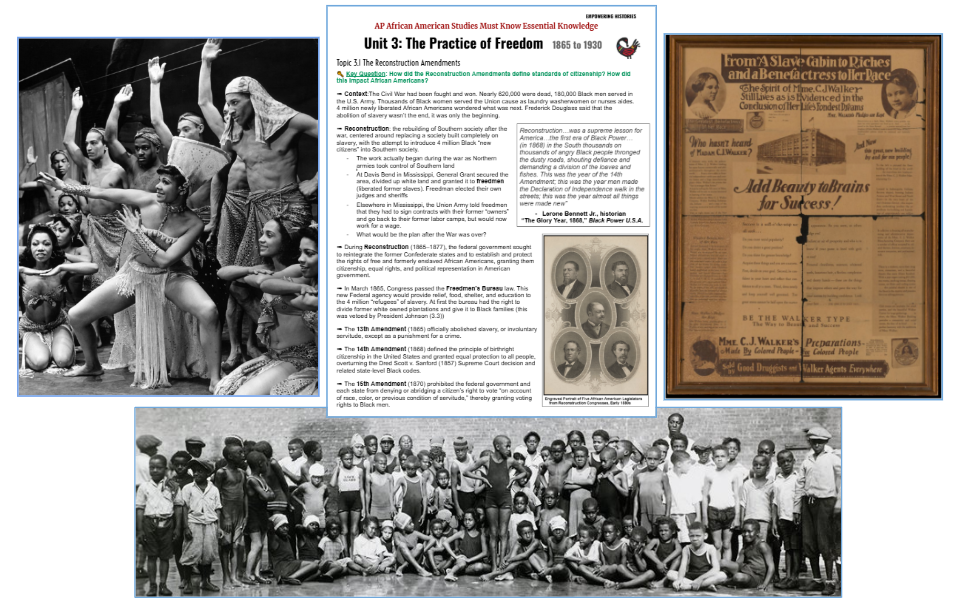Unit 3: The Practice of Freedom
Essential Must KNows, Images, and Study Guide: Unit 3
Intro to the “Essential Must Knows” Document and HoW I use it in my Course
For each AP History course I teach, I have written a “Must Know” document for each unit. This document is the foundation of my class. This is what students should use to study for assessments and to reference throughout the unit. Taking on a new AP course is daunting for any teacher. How do you ensure you cover all of the content and the skills? This document is helpful because it contains all the content students need to know to be successful. Along with the Must Knows, I require my students to fill out a corresponding vocabulary guide. I hope this helps you and your community of scholars! The more citizens who understand the complexities of the African American experience, the better our society will be!
What is it? How I made the “Essential Must Knows” Document
For each course, I start with the College Board’s “Essential Knowledge” standards found in the Course and Exam Description (link to the CED). In AP US History and AP World History, this requires that I select specific historical examples for my students. This is very different in AP African American Studies. Not only does the College Board provide specific sources to read, but the standards are also much more specific. Therefore, the Must Know study guide that I create for my APAFAM students is mostly comprised of College Board language. Based on my students, I find that additional context is sometimes required to help make connections to prior knowledge and help cement their understanding of course content. For example, the APAFAM CED assumes that students already have a grasp of 15th-century European sea voyaging in Unit 1, political developments in the early United States in Unit 2, and a solid background on imperialism in Africa for Unit 4. If students don’t have this background, it is harder for them to analyze, contextualize, and consider “the why” behind some of the required sources and knowledge. Therefore, my APAFAM “Essential Must Knows” document is mostly reformatted College Board language. My additional words come mostly in the form of context.
Perhaps most important for students is that I take 80pages from the CED, add explanations, include all the images, select vocabulary terms to focus on, and put it all in 35 pages.
*** APAFAM is an amazing course and this experience is NOT about AP test scores. In fact, I seriously warn teachers about problems caused by prioritizing AP test scores (blog link). That being said, as a teacher considering a new source, you want to find something of high quality that will work for your students. Using these Must Knows, my class comprised of mostly first-time AP students who were not yet meeting state benchmarks for reading comprehension and scored well above the national average on the pilot exam. The Must-Knows work!
If you are new to teaching AP History, I have included a description of the College Board CED standards below. I also know that many APAFAM teachers have previously taught APUSH or AP World, so I have also included a description of how the APAFAM standards are unique.
AP African American Studies “Essential Knowledge” Standards from the Course & Exam Description
The precision of the College Board’s AP African American Studies “Essential Knowledge” standards is a blessing and a great asset to teachers (and students!) of this course. The AP African American Studies standards are much more explicit than the AP US and AP World History Standards. This provides teachers with exactly what they need to do the job effectively. This was an essential move from the College Board. The standards and required sources were written by a team of leaders in the field of African American Studies.
It is important to note, the College Board does not tell you exactly what or how to teach any of its courses. Teachers have a lot of professional freedom and are strongly encouraged to bring in other topics and resources (I do so in every unit). However, the CED’s standards should be used as a teacher’s most significant guide to planning and curriculum development.
How the AP African American Studies (APAFAM) Differ from other AP History Standards
In AP US History and AP World History, the College Board’s CED standards are fairly vague. For example, in the AP US standards, specific terms and names like “Cuban Missile Crisis” and “Fidel Castro” do not appear. Instead, the College Board just says students need to know an example of how the "Cold War extended to Latin America” and that “the US supported undemocratic, but non-communist regimes.” Teachers then rely on textbooks or materials of their choosing to guide students through specific examples in Cuba, Guatemala, etc.
Compare that to AP African American Studies. In Unit 4, the CED doesn’t just tell teachers that Black Feminism evolved in the 20th century, it expressly instructs that students should know that “the Combahee River Collective was a Boston-based, Black feminist and lesbian organization. Their Collective Statement (1977) argued that Black women’s liberation would free all members of society as it would require the destruction of all systems of oppression (e.g., racism, sexism, classism, homophobia).” There is so much more detail here, and it takes a lot of guesswork out for teachers and students. This is significant and a wise decision from the College Board because while many high school history teachers have degrees in US History, there are comparatively very few high school teachers with degrees in African American Studies.

